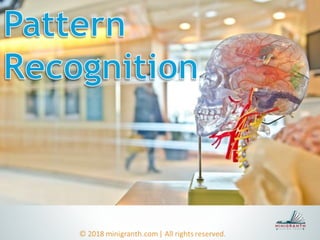
Pattern recognition
- 2. Table of Content 1. Introduction to Pattern Recognition. 2. Pattern Recognition System. 3. Machine Learning. 4. Application of Pattern Recognition. 5. Future of Pattern Recognition.
- 3. Introduction to Pattern Recognition • Pattern Recognition is the branch of machine learning a computer science which deals with the regularities and patterns in the data that can further be used to classify and categorize the data with the help of Pattern Recognition System. • “The assignment of a physical object or event to one of several pre- specified categories”-- Duda & Hart • Pattern Recognition System is responsible for generating patterns and similarities among given problem/data space, that can further be used to generate solutions to complex problems effectively and efficiently. • Certain problems that can be solved by humans, can also be made to be solved by machine by using this process.
- 4. Pattern Recognition System • This system comprises of mainly five components namely sensing, segmentation, feature extraction, classification and post processing. All of these together generates a System and works as follows.
- 5. 1. Sensing and Data Acquisition : It includes, various properties that describes the object, such as its entities and attributes which are captured using sensing device. 2. Segmentation : Data objects are segmented into smaller segments in this step. 3. Feature Extraction : In this step, certain features of data objects such as weight, colors, dimension etc. are extracted. 4. Classification : Based on the extracted features, data objects are classified. 5. Post Processing & Decision : Certain refinements and adjustments are done as per the changes in features of the data objects which are in the process of recognition. Thus, decision making can be done once, post processing is completed.
- 6. Machine Learning • According to Arthur Samuel, Machine Learning can be defined as the “ computers that has ability to learn without being explicitly programmed”. • It means that, machine learning is a branch of computer science which enables computer systems to learn and respond to queries on the basis of experience and knowledge rather than from predefined programs. • It can be used to study data, construct algorithms for it and can further make predictions on the data. Machine learning can be classified into three categories, depending upon the nature of learning. These are:
- 7. SupervisedLearning • When learning of a function can be done from its inputs and outputs, it is called as supervised learning. • One of the example of supervised learning is “Classification”. It classifies the data on the basis of training set available and uses that data for classifying new data. • The class labels on the training data is known in advance which further helps in data classification. Un-SupervisedLearning • When learning can be used to draw inference from some data set containing input data, it is called as unsupervised learning. • It clusters the data on the basis of similarities according to the characteristics found in the data and grouping similar objects into clusters. • The class labels on the training data is not known in advance i.e. no predefined class.
- 8. ReinforcementLearning • Reinforcement in general is, the action or process of establishing a pattern of behaviour. • Hence, Reinforcement learning is the ability of software agents to learn and get reinforced by acting in environment i.e. learning from rewards. • In reinforcement learning, the software agents acts upon the environment and gets rewarded for its action after evaluation but is not told, of which action was correct and helped it to achieve the goal. For Example: Game Playing, Statistics. • The problem of unsupervised learning involves learning patterns from the inputs when specific output values are supplied. • Clustering is an example of unsupervised learning which can further be used on the basis of different methods as per requirements.
- 9. Application of Pattern Recognition • Pattern Recognition possesses a number a application in real world scenarios. Some of them are listed below. 1. Character Recognition. 2. Weather Prediction. 3. Sonar Detection. 4. Image Processing. 5. Medical Diagnosis. 6. Speech Recognition. 7. Information Management Systems.
- 10. Future of Pattern Recognition • Future of Pattern Recognition : It is a vast area of research and there are endless number of possibilities as pattern recognition is still under research as it is getting more futuristic and intelligent with a great affect in human life in a positive manner. • Since there are endless number of research options and some of them are listed below. 1. Computer vision. 2. Natural Language Processing. 3. Game Playing. 4. Speech and Handwriting recognition. 5. Search engines. 6. Opinion mining. 7. Sequence mining. 8. Robotics. 9. Software engineering. 10. Medical Diagnosis.
- 11. A Brief Presentation on Pattern Recognition By The Minigranth Team. To know more about Pattern Recognition Visit us at : minigranth.com E-mail : minigranth@gmail.com Thank You !
